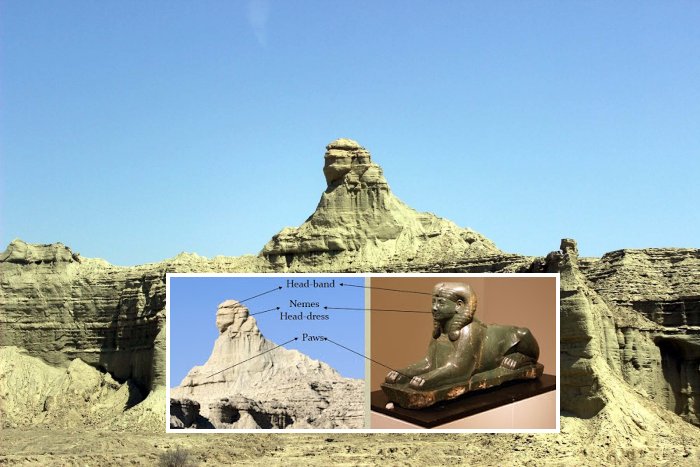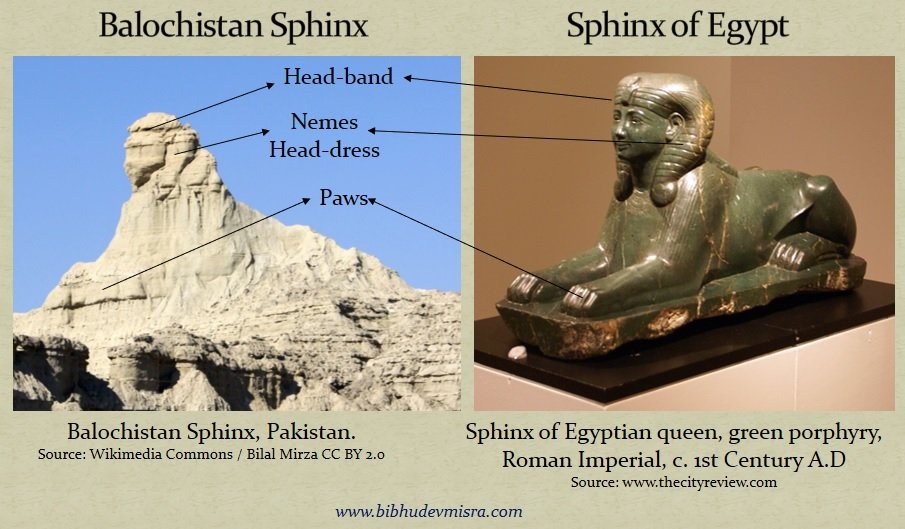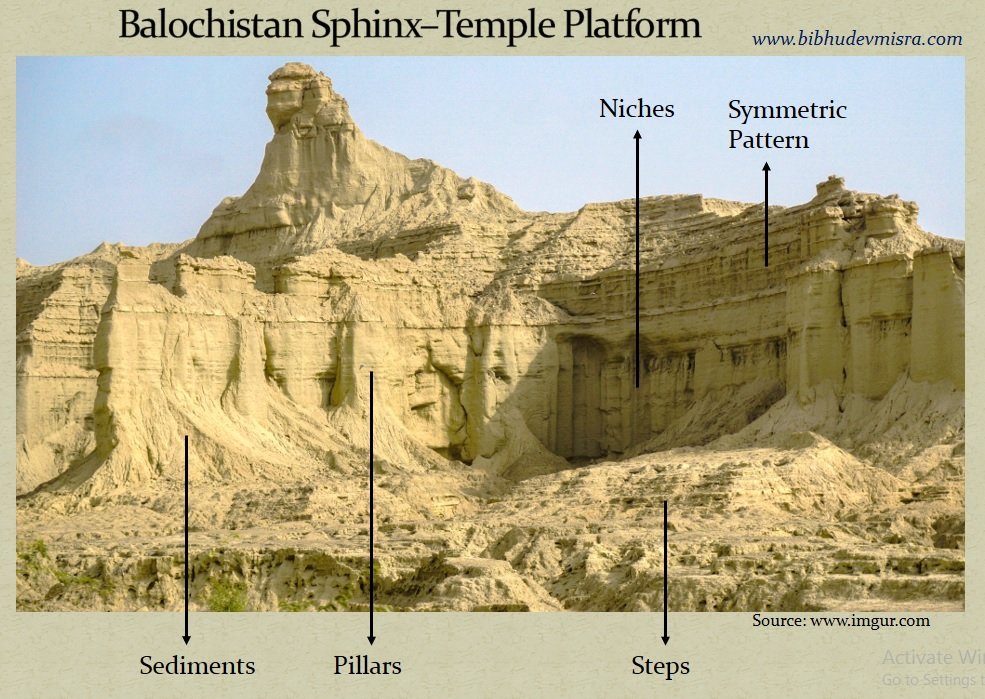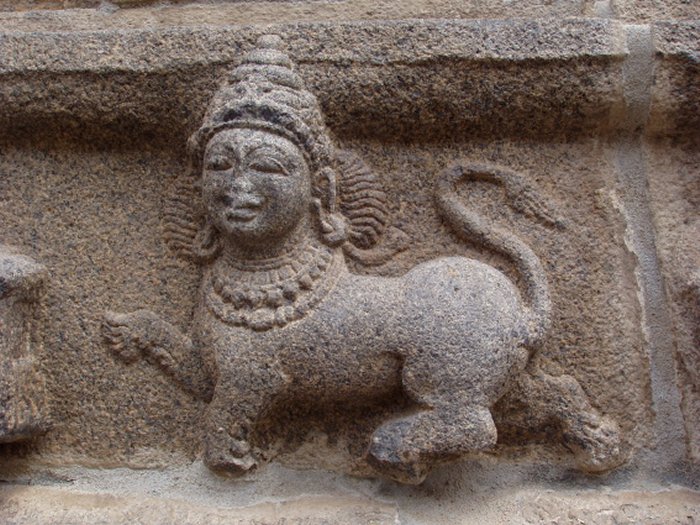Mysterious Balochistan Sphinx Has An Ancient Story To Tell – But Is An Advanced Ancient Civilization Or Mother Nature Hiding Behind The Story?
Ellen Lloyd - AncientPages.com - Do we see artificial structures in works created by Mother Nature simply because we want to believe they are man-made? Or do we deliberately dismiss ancient constructions as natural formations because these buildings contradict our version of recorded history?
Can we judge something like a natural formation without conducting proper archaeological and scientific examination? Some so-called natural formations are baffling, and the Sphinx of Pakistan belongs to that category.
The Balochistan Sphinx is far from as famous as the Great Sphinx of Giza in Egypt. Located on the Makran coastline of Southern Balochistan in Pakistan's Hingol National Park, the Balochistan Sphinx has an ancient story to tell.
Most think the Balochistan Sphinx was carved by wind and rain and is nothing more than a natural formation, but some are of a different opinion.
Balochistan Sphinx in Pakistan - Credit: Wikipedia
The Sphinx of Pakistan has stood there unnoticed and unexplored for centuries. It was first in 2004 that the public learned about its existence.
Researcher Bibhu Dev Misra from the Indian Institute of Technology (IIT) Kharagpur and the Indian Institute of Management (IIM) Kolkata believes the Balochistan Sphinx is a huge architectural complex created by an advanced ancient civilization. According to Bidhu Dev Mistra Balochistan Sphinx’s headdress closely resembles the Nemes headdress of the Egyptian pharaoh.
The Indian researcher also points out that ear-flaps can be clearly seen on the Balochistan Sphinx and contours of the reclining forelegs of the sphinx, which terminate in very well-defined paws.
“It is ridiculous to suggest that nature has carved out a statue which resembles a well-known mythical animal to such an extraordinarily high degree. It appears that absolutely no attempt has been made for their restoration. Both the authorities and the journalists are only too happy to pass them of as “natural formations”. The situation can only be salvaged if international attention can be drawn to these grand structures and if teams of archaeologists (as well as enthusiasts) from around the globe visit these enigmatic monuments to research, restore, and publicize them.
Is the Balochistan Sphinx a cousin of the Egyptian Sphinx? Credit: Bibhu Dev Misra
The importance of these ancient monuments of the Makran coast can hardly be overstated – they could literally be thousands of years old – and they can potentially provide us with important clues to uncover humanity’s mysterious past,” Bibhu Dev Misra says.
Was the Balochistan Sphinx erected to guard an ancient temple? Credit: Bibhu Dev Misra
Bibhu Dev Misra’s research into the Balochistan Sphinx is impressive and very interesting.
Raja Deekshithar (1949-2010), discovered the Sphinx in the Indian civilization concluded that the primary position of the mythological animal was near the temple gateway, acting as a guardian of the sanctuary. If the Balochistan Sphinx is man-made, was it erected to guard an ancient unknown temple on the Makran coastline?
As we wrote previously on Ancient Pages, the Sphinx was by no means limited not ancient Egypt.
The Sphinx was considered a keeper of the holy places and the mysteries of life. It was a guardian of knowledge and symbol of riddles and intrigue. Regarded as a creature full of secrets, several ancient civilizations erected a sphinx in their lands. We find evidence of the Sphinx’s existence in ancient Greece, Babylon, India and other places.
Sphinx of India - Credit: Rajadeekshitar - CC BY-SA 3.0
The Sphinx of India, known as purushamriga, has almost always elongated earlobes decorated with ornamental disks. In Sanskrit, “Purushamriga” means human-beast. There are several references to this divine being in the great Indian epics, the Ramayana, the Mahabharata, and some of the Puranas. We also encounter the Sphinx in Vedic literature.
Its numerous depictions carved in wood, metal, and painted are found in many temples of India.
Whether the Balochistan Sphinx is a man-made structure or a natural formation cannot be determined at this point. The Sphinx of Pakistan certainly does have an ancient story to tell. The question is, who is hiding behind the story – an advanced ancient civilization or Mother Nature?
Written by Ellen Lloyd – AncientPages.com
Updated on January 20, 2024
Copyright © AncientPages.com All rights reserved. This material may not be published, broadcast, rewritten or redistributed in whole or part without the express written permission of AncientPages.com
Expand for referencesMore From Ancient Pages
-
 Patara Lighthouse Built By Emperor Nero In 64 AD Will Shine Again
Archaeology | Mar 5, 2020
Patara Lighthouse Built By Emperor Nero In 64 AD Will Shine Again
Archaeology | Mar 5, 2020 -
 Melipona Beecheii – Sacred Ancient Maya Beekeeping Site Discovered In Quintana Roo, Mexico
Archaeology | May 28, 2024
Melipona Beecheii – Sacred Ancient Maya Beekeeping Site Discovered In Quintana Roo, Mexico
Archaeology | May 28, 2024 -
 Your Neanderthal Genes May Prevent You From Metabolizing Drugs Efficiently
Archaeology | Jul 25, 2022
Your Neanderthal Genes May Prevent You From Metabolizing Drugs Efficiently
Archaeology | Jul 25, 2022 -
 3,300-Year-Old Bronze Figurine Of Canaanite God Unearthed At Lost Biblical City
Archaeology | Apr 12, 2020
3,300-Year-Old Bronze Figurine Of Canaanite God Unearthed At Lost Biblical City
Archaeology | Apr 12, 2020 -
 On This Day In History: Execution Of Saints Crispin And Crispinian – On Oct 25, 286
News | Oct 25, 2016
On This Day In History: Execution Of Saints Crispin And Crispinian – On Oct 25, 286
News | Oct 25, 2016 -
 Mystery Of The Large Ancient Boulders In Ireland And Britain – Possible Connection To The City Of Troy?
Featured Stories | Oct 17, 2023
Mystery Of The Large Ancient Boulders In Ireland And Britain – Possible Connection To The City Of Troy?
Featured Stories | Oct 17, 2023 -
 Mysterious Ancient Egyptian Royal Tomb Sheds Light On Little-Known Abydos Dynasty
Archaeology | Mar 17, 2025
Mysterious Ancient Egyptian Royal Tomb Sheds Light On Little-Known Abydos Dynasty
Archaeology | Mar 17, 2025 -
 Researchers Reconstruct Genome Of Centuries-Old E. Coli Using Fragments Extracted From An Italian Mummy
News | Jun 18, 2022
Researchers Reconstruct Genome Of Centuries-Old E. Coli Using Fragments Extracted From An Italian Mummy
News | Jun 18, 2022 -
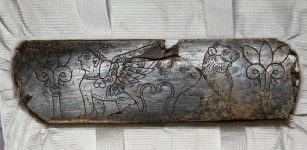 Unique 2,800-Year-Old Ivory Object Unearthed At Hattusa
Archaeology | Nov 14, 2023
Unique 2,800-Year-Old Ivory Object Unearthed At Hattusa
Archaeology | Nov 14, 2023 -
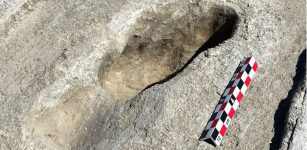 88 Ice Age Human Footprints In Utah Desert Shed New Light On Ancient Americans
Archaeology | Aug 11, 2022
88 Ice Age Human Footprints In Utah Desert Shed New Light On Ancient Americans
Archaeology | Aug 11, 2022 -
 Evidence Vikings Had Windows With Glass Panes Already Between 800 And 1100
Archaeology | Oct 11, 2023
Evidence Vikings Had Windows With Glass Panes Already Between 800 And 1100
Archaeology | Oct 11, 2023 -
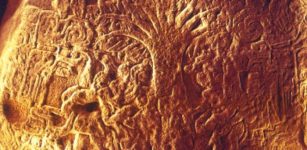 Ceiba Tree: Sacred Tree Of Life Of Maya People And Universal Concept In Ancient Beliefs
Celtic Mythology | Jun 12, 2017
Ceiba Tree: Sacred Tree Of Life Of Maya People And Universal Concept In Ancient Beliefs
Celtic Mythology | Jun 12, 2017 -
 Four Canopic Jars Dated To The 26th Dynasty Unearthed At South Asasif Necropolis, Luxor
Archaeology | Jun 27, 2018
Four Canopic Jars Dated To The 26th Dynasty Unearthed At South Asasif Necropolis, Luxor
Archaeology | Jun 27, 2018 -
 On This Day In History: British Fleet Attacked The Spanish ‘Invincible Armada’ – On July 21, 1588
News | Jul 21, 2016
On This Day In History: British Fleet Attacked The Spanish ‘Invincible Armada’ – On July 21, 1588
News | Jul 21, 2016 -
 Yam: Tyrannical Hydra-Like Sea Monster God Cast Out Of Heaven
Featured Stories | Aug 3, 2016
Yam: Tyrannical Hydra-Like Sea Monster God Cast Out Of Heaven
Featured Stories | Aug 3, 2016 -
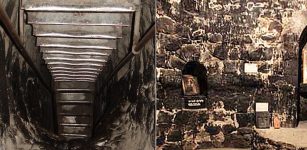 Nearly 2,000-Year-Old Aqueduct Discovered Near Ancient Monastery Khor Virap In Armenia
Archaeology | Jan 29, 2020
Nearly 2,000-Year-Old Aqueduct Discovered Near Ancient Monastery Khor Virap In Armenia
Archaeology | Jan 29, 2020 -
 Justinianic Plague Struck England Before It Reached Constantinople And It Did Not Wipe Out The Roman Empire
Archaeology | Nov 19, 2021
Justinianic Plague Struck England Before It Reached Constantinople And It Did Not Wipe Out The Roman Empire
Archaeology | Nov 19, 2021 -
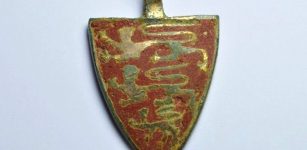 Priceless 800-Year-Old Treasure Featuring Three Golden Lions Unearthed
Archaeology | Aug 5, 2022
Priceless 800-Year-Old Treasure Featuring Three Golden Lions Unearthed
Archaeology | Aug 5, 2022 -
 12 Ancient Egyptian Symbols Explained
Ancient Symbols | May 9, 2017
12 Ancient Egyptian Symbols Explained
Ancient Symbols | May 9, 2017 -
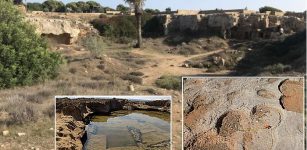 Rediscovery Of Lost Tombs And Quarries On A British Military Base In Cyprus
Archaeology | Mar 7, 2024
Rediscovery Of Lost Tombs And Quarries On A British Military Base In Cyprus
Archaeology | Mar 7, 2024

